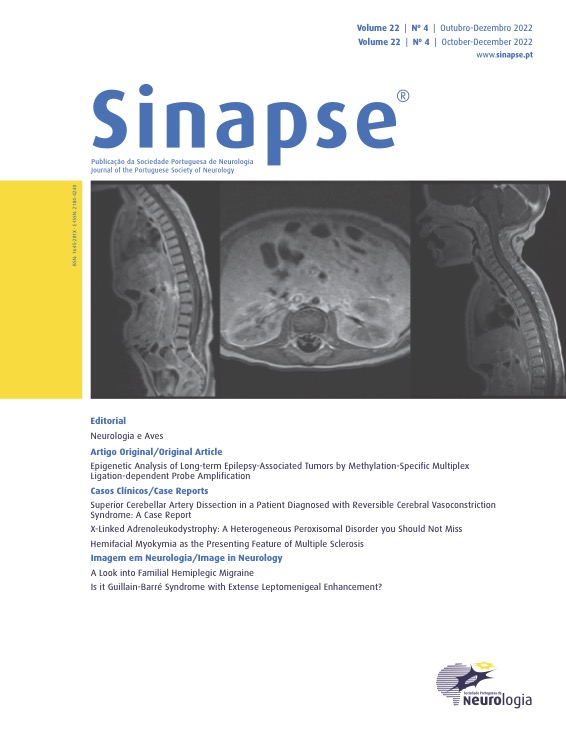Adrenoleucodistrofia Ligada ao X: Uma Doença Peroxissomal Heterogénea de Diagnóstico Obrigatório
DOI:
https://doi.org/10.46531/sinapse/CC/220057/2022Palavras-chave:
Adrenoleucodistrofia/ diagnóstico, Adrenoleucodistrofia/genética, Adrenoleucodistrofia/ tratamentoResumo
A adrenoleucodistrofia ligada ao X (X-ALD) é uma doença peroxissomal rara causada por uma mutação no gene ABCD1, e que compromete a b-oxidação peroxissomal dos ácidos gordos de cadeia muito longa. Tem uma apresentação clínica heterogénea que pode tornar o diagnóstico difícil, com três fenótipos principais: um fenótipo síndrome de Addison-like com insuficiência suprarrenal; a forma mieloneuropática, que progride com uma paraparésia espástica; e uma forma cerebral com desmielinização cerebral potencialmente extensa. As mulheres podem apresentar-se com um fenótipo que se assemelha à forma mieloneuropática, mas com progressão lenta. O reconhecimento e diagnóstico atempados são essenciais, uma vez que o transplante alogénico de células estaminais hematopoiéticas pode estar indicado para a forma cerebral da doença, o fenótico com pior prognóstico. Apresentamos quatro casos clínicos de pacientes com X-ALD seguidos no nosso centro de referência de doenças neurometabólicas, enfatizando as diferentes apresentações clínicas, abordagem diagnóstica, seguimento e possíveis pistas para o diagnóstico.Downloads
Referências
Aubourg P, Wanders R. Peroxisomal disorders. Handb Clin Neurol. 2013;113:1593-609. doi: 10.1016/B978-0-444-59565-2.00028-9.
Berger J, Forss-Petter S, Eichler FS. Pathophysiology of X-linked adrenoleukodystrophy. Biochimie. 2014;98:135-42. doi: 10.1016/j.biochi.2013.11.023.
Huffnagel IC, Laheji FK, Aziz-Bose R, Tritos NA, Marino R, Linthorst GE, et al. The Natural History of Adrenal Insufficiency in X-Linked Adrenoleukodystrophy: An International Collaboration. J Clin Endocrinol Metab. 2019;104:118-26. doi: 10.1210/jc.2018-01307.
Engelen M, Kemp S, Poll-The BT. X-linked adrenoleukodystrophy: pathogenesis and treatment. Curr Neurol Neurosci Rep. 2014;14:486. doi: 10.1007/s11910-014-0486-0.
Engelen M, Kemp S, de Visser M, van Geel BM, Wanders RJ, Aubourg P, et al. X-linked adrenoleukodystrophy (X-ALD): clinical presentation and guidelines for diagnosis, follow-up and management. Orphanet J Rare Dis. 2012;7:51. doi: 10.1186/1750-1172-7-51.
Turk BR, Theda C, Fatemi A, Moser AB. X-linked adrenoleukodystrophy: Pathology, pathophysiology, diagnostic testing, newborn screening and therapies. Int J Dev Neurosci. 2020;80:52-72. doi: 10.1002/jdn.10003.
Mallack EJ, Turk B, Yan H, Eichler FS. The Landscape of Hematopoietic Stem Cell Transplant and Gene Therapy for X-Linked Adrenoleukodystrophy. Curr Treat Options Neurol. 2019;21:61. doi: 10.1007/s11940-019-0605-y.
Fadiga L, Melo M, Saraiva J, Paiva I. The clinical spectrum of X-linked adrenoleukodystrophy: from Addison’s-only in men to middle-age neurologic manifestations in women. Hormones. 2022;21:33-40. doi: 10.1007/s42000-021-00325-y.
Husebye ES, Allolio B, Arlt W, Badenhoop K, Bensing S, Betterle C, et al. Consensus statement on the diagnosis, treatment and follow-up of patients with primary adrenal insufficiency. J Intern Med. 2014;275:104-15. doi: 10.1111/ joim.12162.
Liberato AP, Mallack EJ, Aziz-Bose R, Hayden D, Lauer A, Caruso PA, Musolino PL, Eichler FS. MRI brain lesions in asymptomatic boys with X-linked adrenoleukodystrophy. Neurology. 2019;92:e1698-708. doi: 10.1212/ WNL.0000000000007294.
M Mallack EJ, Turk BR, Yan H, Price C, Demetres M, Moser AB, et al. MRI surveillance of boys with X-linked adrenoleukodystrophy identified by newborn screening: Meta-analysis and consensus guidelines. J Inherit Metab Dis. 2021;44:728-39. doi: 10.1002/jimd.12356.
Mahmood A, Raymond GV, Dubey P, Peters C, Moser HW. Survival analysis of haematopoietic cell transplantation for childhood cerebral X-linked adrenoleukodystrophy: a comparison study. Lancet Neurol. 2007;6:687-92. doi: 10.1016/ S1474-4422(07)70177-1.
Lee AG, Olson RJ, Bonthius DJ, Phillips PH. Increasing exotropia and decreasing vision in a school-aged boy. Surv Ophthalmol. 2007;52:672-9. doi: 10.1016/j.survophthal.2007.08.020.
Gupta AO, Nascene DR, Shanley R, Kenney-Jung DL, Eisengart JB, Lund TC, et al. Differential outcomes for frontal versus posterior demyelination in childhood cerebral adrenoleukodystrophy. J Inherit Metab Dis. 2021;44:1434-40. doi: 10.1002/jimd.12435.
Miller WP, Rothman SM, Nascene D, Kivisto T, DeFor TE, Ziegler RS, et al. Outcomes after allogeneic hematopoietic cell transplantation for childhood cerebral adrenoleukodystrophy: the largest single-institution cohort report. Blood. 2011;118:1971-8. doi: 10.1182/blood-2011-01-329235.
Moser AB, Seeger E, Raymond GV. Newborn Screening for X-Linked Adrenoleukodystrophy: Past, Present, and Future. Int J Neonatal Screen. 2022;8:16. doi: 10.3390/ijns8010016.
Bessey A, Chilcott JB, Leaviss J, Sutton A. Economic impact of screening for X-linked Adrenoleukodystrophy within a newborn blood spot screening programme. Orphanet J Rare Dis. 2018;13:179. doi: 10.1186/s13023-018-0921-4.
Loes DJ, Fatemi A, Melhem ER, Gupte N, Bezman L, Moser HW, et al. Analysis of MRI patterns aids prediction of progression in X-linked adrenoleukodystrophy. Neurology. 2003;61:369-74. doi: 10.1212/01. wnl.0000079050.91337.83.
Weinhofer I, Rommer P, Zierfuss B, Altmann P, Foiani M, Heslegrave A, et al. Neurofilament light chain as a potential biomarker for monitoring neurodegeneration in X-linked adrenoleukodystrophy. Nat Commun. 2021;12:1816. doi: 10.1038/s41467-021-22114-2.
Waldhüter N, Köhler W, Hemmati PG, Jehn C, Peceny R, Vuong GL, et al. Allogeneic hematopoietic stem cell transplantation with myeloablative conditioning for adult cerebral X-linked adrenoleukodystrophy. J Inherit Metab Dis. 2019;42:313-24. doi: 10.1002/jimd.12044.
Palakuzhiyil SV, Christopher R, Chandra SR. Deciphering the modifiers for phenotypic variability of X-linked adrenoleukodystrophy. World J Biol Chem. 2020;11:99-111. doi: 10.4331/wjbc.v11.i3.99.
Huffnagel IC, Dijkgraaf MG, Janssens GE, van Weeghel M, van Geel BM, Poll-The BT, et al. Disease progression in women with X-linked adrenoleukodystrophy is slow. Orphanet J Rare Dis. 2019;14:30. doi: 10.1186/s13023-019-1008-6.
Engelen M, Barbier M, Dijkstra IM, Schür R, de Bie RM, Verhamme C, et al. X-linked adrenoleukodystrophy in women: a cross-sectional cohort study. Brain. 2014;137:693-706. doi: 10.1093/brain/awt361.
Downloads
Publicado
Como Citar
Edição
Secção
Licença
Direitos de Autor (c) 2024 Pedro Lopes das Neves, João Durães, Isabel Monteiro, Luísa Diogo, Maria do Carmo Macário

Este trabalho encontra-se publicado com a Creative Commons Atribuição-NãoComercial 4.0.








